PATTI MCGEE
Interview by STEVE OLSON Photos courtesy of PATTI MCGEE
The Handstand that was for LIFE…
MAGAZINE,
that is, pretty cool too…
Patti McGee, the blonde on the cover…
From the past into the future…
One woman’s stories about how it was
to NOW… Life is interesting that’s for sure…
Just ask Patti McGee, she’ll tell ya…
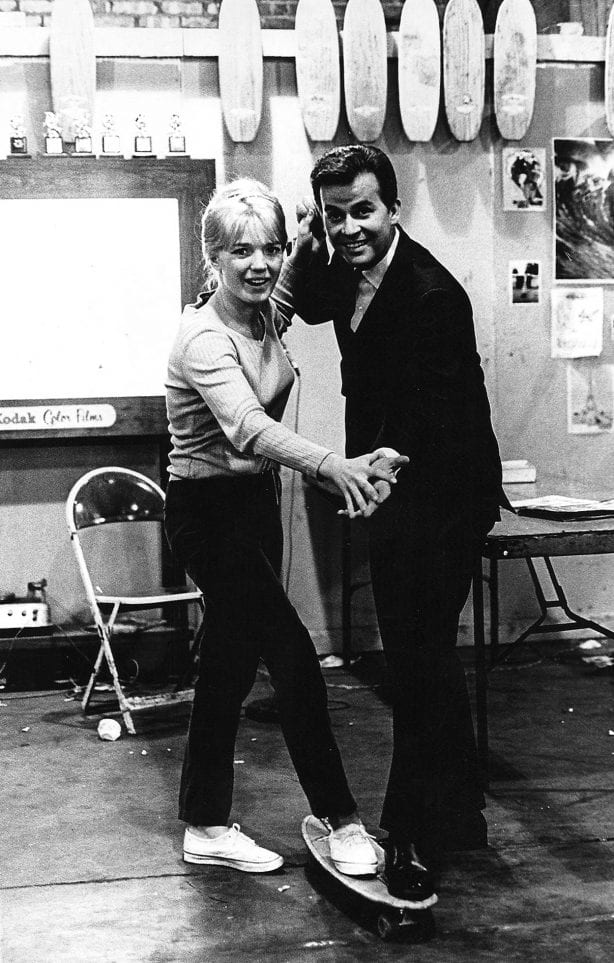
Hello, Patti. How are you?
I’m trying to be good.
Good. Okay. First things first. When and how did you ever start skateboarding?
1962. It was a natural. Surfing and skateboards came along and I did it.
Where were you?
I lived in Point Loma, San Diego.
How did you come across a skateboard?
My brother is responsible for that. He always had wheels of some sort. We were sitting on a plank with roller-skates on it and we had our feet up and then we had them with a box on it, and that didn’t last very long. We probably broke it. Then I remember my brother yelling at me, “Come out here! You have to try this!” He had stolen the wheels off of my rink skates, and attached them to a board he made in wood shop. That was it. He was skating with Tommy Ryan at the time.
How old were you then?
I was 17 or 18. My brother and Tommy Ryan were gremmies then. They were five years younger.
Before skateboarding, were you surfing?
Yes. I started surfing in 1958. I had an old balsa board with a real round deck. It was about 18” wide. It was a Burland shaped by Fox. He wrote his name right on the stringer.
So the natural progression from surfing over to skateboarding was easy for you?
Yes. You know how it was in the parking lot when there was no surf. Everyone was sitting around the car, smoking cigarettes and eating Twinkies, I guess. I was never one to sit on the beach or hang out in the car. I had to be doing something and skateboarding was perfect.
Why was skateboarding perfect for you?
Well, it was action. You had to have some action. In the afternoon, the beach break always blows out and I wasn’t ready to go home and do my homework, so we skateboarded up and down the street in Ocean Beach. We started skating the hill on Loring Street in Pacific Beach. That was a challenge. That was like surfing a big wave, if you could make it. I also hung out at Windansea and there were a couple of hills there, so we skated that. It was anything to be rowdy.
Were you part of the Windansea crew?
I was part of the Pump House Gang. Most of the kids were from La Jolla High, and I was not. I surfed Windansea, so we’d hang out at the bottom of the stairs at the Pump House and I got on the shore break. When it was just right, we’d paddle out to the point and catch waves. I didn’t hang out in the parking lot because that was all the big guys, like Anchovy, Butch Van Artsdalen and those guys. We didn’t hang out with them. We were little, as far as they were concerned, even though we were 16, 17, 18. When I was 18, the Pump House Gang came to a screeching halt.
Tell me the story.
Tom Wolfe wrote a book about it called The Pump House Gang. There was a couple – Donna had come from the Army and Leonard was her boyfriend. He was a surfer Pump House Gang dude from La Jolla High. They committed suicide at the base of the steps in front of everybody. It was so weird. I was driving over there when I heard it on the radio and I just kept driving until midnight when I pulled into some beach in Santa Barbara. I couldn’t face it. It just blew my mind. It was just too heavy. There were a lot of kids that saw it happen and it was just horrible. That was the end of San Diego for me.
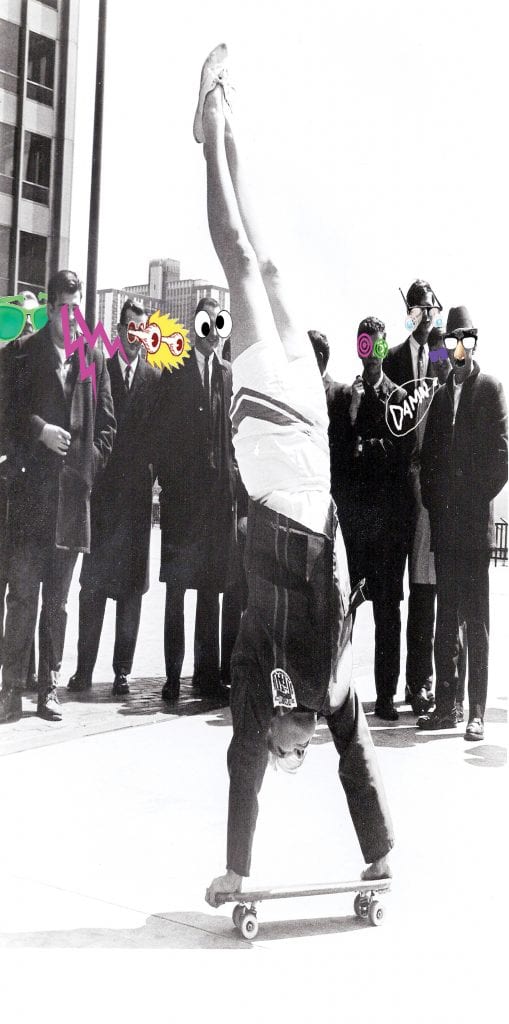
Were you still skateboarding?
Oh yeah. That was in ‘63 and the contest in Santa Monica was in ‘64 and I continued my skateboarding shenanigans. I was hanging out with Pacific Beach people and then they opened up the Concourse in downtown San Diego and they had a parking garage. That became our Mount Everest or Waimea Bay or Sunset Beach. We were always getting in trouble. We had to park farther and farther away and sneak in. Sometimes we didn’t skate all the way to the bottom, so we didn’t get caught. We’d have to bail and then sneak back up. The parking garage was a rush. Not only did you have to sneak into it, but it was not easy and, if you screwed up, you were toast because we were riding barefoot. You had to cutback to slow down.
What kind of board were you riding?
I was riding a Bun Buster with Chicago wheels. They were the same wheels that my brother took off my rink skates. It was a Bun Buster by George Cooley. I always said if I could ever find George Cooley of Bun Buster, I was going to take him to the Skateboarding Hall of Fame. In 2015, I found him and I took him to the Hall of Fame as my date. It was like my payback.
Oh nice. What did he think of that?
He was absolutely blown away. I had mentioned to David Hackett that I was bringing George, so before the awards started, David said, “Before we get going I want you all to know that there are a couple of people in the audience and one of them is George Cooley of Bun Buster Skateboards.” I thought that George was going to fall over backwards in his chair. I didn’t ask David to do that. I just wanted him to know. I was so proud that I was able to keep my word and that George was still well and alive. George Cooley is 82 now. I was really proud to be able to do that. All night long he just kept saying, “I can’t believe it. I just can’t believe all the people in this room are skateboarders.” He was absolutely stoked.
That is so cool. How did you get onto the Bun Buster team? It was called Bun Buster?
Yeah. That was the name of the skateboard, Bun Buster by George Cooley. He came out with a Yuba wood deck with the name screen-printed on the deck. There was a longer model called the Challenger and then there was the Stingray. The wheels on the Challenger were red because those were the Chicago wheels off the roller-skates. He made a deal with a Chicago Roller Skates rep for all of these wheels. He got all of these orders from a local drug store and then he had to hurry up and build them. I met George through my cousin, big Pat McGee, from Ocean Beach. My cousin was a rugby player and he met George Cooley in Whittier or Redondo Beach. He told George, “You need to have a skateboard team and I know just the two skateboarders.” It was me and my brother. In 1964, we went up there and met him and he gave us some skateboards. He told us that he was going to put together a tour to Colorado because there was going to be a premiere of a Hayley Mills movie, The Moon-Spinners, and Walt Disney was going to be in the crowd for the premiere. George flew us in and they rolled out the carpet and we got the treatment and a bunch of guys in suits met us.
What were the suits wanting from you?
They were just meeting us and taking our pictures and making sure we had our accommodations, so they must have been from the theatre in Boulder.
What was the movie about that related to you guys being flown in there?
It had nothing to do with skateboarding. It was a Walt Disney movie premiere and Walt Disney was going to be in the audience and somehow George Cooley got us booked to be the entertainment. The distance between the curtains and the footlights was like three feet, so we did jump over the stick and stuff like that.
Oh really? This was you and your brother?
Yeah. There was another guy too, except we’ve lost contact with him.
Would it be safe to consider you the first professional female skateboarder?
Well, I was still an amateur then.
There were other girls that were skateboarding then, right?
I think so, but not so much in San Diego. There’s a difference between skateboarding and being a skateboarder. Of course, there were other surfer girls that got on a skateboard and pushed around. I was the president of an all girls surf team in ‘63. We had a competition ladder and, at one time, I was number one, which was really cool. I competed in all the contests up and down the coast. My last contest was at Huntington Beach. I got third in my heat, so I didn’t get to go to the finals. I was disappointed. These girls I was competing against had surf training. For instance, Linda Benson’s parents flew her to Hawaii and her dad surfed and he coached her. I was just a rowdy surfer.
You were just a rowdy surfer?
Sure. Girls had to be aggressive because guys would just push you out of the way or kick out into your ankles, like, “My wave.”
That’s not so nice.
No. Since when were guys nice in the water? They are so much more gentlemanly now. You would never know this because if you go out, you get all the respect, but, when you were 14, how much respect did you give guys that weren’t local or girls that got in the way?
Well, you know.
Yeah. I do know. [Laughs] That’s why I’m saying what I’m saying. Anyway, let’s get off of surfing.
Okay. Did you start competing in skateboarding?
Yeah. I won that one contest, and then I took my act and my 8×10 glossy photos to Hobie and said, “I want to be on your team.” I’d actually changed a tire for a lady on the Santa Monica Freeway and she gave me $10, and I went, “Wow! I’m taking that $10 and my plastic gold trophy and my 8×10 glossy photographs and I’m going to go down to Dana Point and I’m going to tell Hobie that I want to ride for him.” As I pulled into the shop at Dana Point at 5 o’clock, Hobie was racing out the door in his suit with his folders and skateboards and all of this stuff in his arms. He said, “I haven’t got time for this.” I said, “But look! I’m the Woman’s National Skateboard Champion and I want to be on your team!” He said, “Can you babysit?”
No.
Yes. His wife had broken her leg skiing Mammoth that afternoon and she was being EMTed to the house and he had to be on a plane to New York asap. That’s why he was all dressed up. He was going to the Macy’s department store and he was putting together this huge promotion. By that afternoon, I had met his kids and he had taken off for New York. There I was in the house in Laguna waiting for the EMTs to bring his wife. Jeff Alter was only two. Jeff and Hobie Jr. are taking the Hobie business and running with it now.
Did Hobie put you on the team?
I was his demo girl, but I didn’t ride with Stevie, Davey, Torger and the other guy with the dog.
Why didn’t you ride with those guys?
They were all 14. I was 19. Every time I arrived at a city, I was met by a toy representative, like for Tonka Toys in New York and I was already pre-booked by Macy’s Department Store. I just went where I was told, but I didn’t need a chaperone and I could check into a hotel by myself. I was 19, and I already knew it all, right? [Laughs]
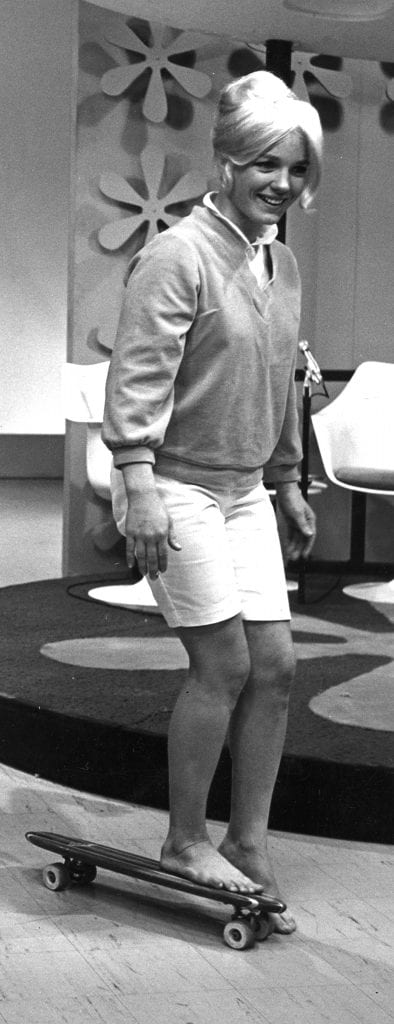
Sure. So you were the demo girl and they were his competition team?
Yeah. At that point, I had my contract, and I was getting paid for doing demonstrations and I traveled all over. I started out in Pittsburgh and went to West Virginia and ended up in New York and then went up to Connecticut. I had a limo driver. That was cool.
So you get on a plane in California and you fly to the East Coast and you get paid to skate. Did you get paid well?
Well, no, probably not in comparison to today’s standards, but neither did baseball players.
You were still getting paid to do something you loved, which was fantastic.
Yes. Then I got on the cover of Life magazine and I could hardly breathe.
That’s getting too far ahead. I want to know more about your demos and the limo drivers and all that jive.
While I was babysitting for Hobie and taking care of his wife who had a broken leg, he was using those 8×10 glossy black and white photos of me skating in front of his shop. He took those to New York and sold me as the package. It was so cool.
He was hustling already.
Yeah. He got together with Tonka Toys and then he made sure that I got to Macy’s Department Store. The Fifth Avenue Toy Center was my contact in New York City, and Macy’s was making sure that I had a very nice place to stay and that I had a limo driver. I was part of their Fifth Floor California promotion and I showed my movie and did my demo three times a day. There were a lot of people on that summer tour for Catalina, like Mike Doyle and Linda Benson. They cruised through the fifth floor when I was there doing my demos. When I wasn’t doing demos, somebody had me booked. Everybody was taking care of me. I just did what I was told. I was taken where I was supposed to do my demo and I did it and I showed my movie and signed autographs for the kids and showed them Hobie Skateboards. At this point, the Hobie skateboard had moved out of the toy section and into the sporting goods section. There was a transition that year from skateboards being toys to skateboards being equipment.
What did your demos consist of?
I walked the board up and walked it back and did some 180s and a couple of 360s. If I had the props with me, I would jump over the stick. Of course, the finale was my handstand.
How many kids would be at these demos?
It was around 25. The other department store where I was pre-booked was Montgomery Ward. A week before I got there, my picture was in the sports section of the newspaper, and the second I landed in New York, the Life magazine came out. I had flown from LAX to Pittsburgh Pennsylvania, and my rep took me to Wheeling, West Virginia and down into all those coal towns and I was doing demos at Montgomery Ward. In the Montgomery Ward days, the downstairs area was for appliances and sporting goods, so I would do my demos down there. They’d have an area flagged off and kids from all over showed up. There would be 30 or 40 kids just waiting for little Patti McGee.
What did the kids think of your skateboarding skills?
Well, they couldn’t do it, but it didn’t take them long. They could probably do everything I could by the end of the weekend.
Right. At first they were blown away by it?
Yeah. I got tons of attention and applause and I was stoked. About a year later, I was flown into Chicago to do the Dick Clark Young World’s Fair and the news wanted me to go out and do the weather while I was doing a handstand.
Oh, no! They wanted you to actually do the weather upside down?
Yes. I have the picture to prove it. My rep is holding my ankles, but he’s out of the shot. There is a guy laying down with a microphone in my face. Off to the right, there was a guy with a big newsreel camera and I was doing the weather. They told me what to say and I said it while I skated.
That is amazing. Do you remember what the weather was like?
It was nice, but I do remember that all the guys were wearing trench coats and that creeped me out. I have a picture of me doing a handstand and all these guys were just standing around gawking at me in their overcoats. I just had on my outfits. I always said that I hated that picture, so for my last Silly Girl skateboard, my daughter, Hailey, put that photo as the graphic on the deck. She Snapchatted all these eyeballs popping out and going, “Boing!” This one guy is going, “Damn!” I went with Silly Girl Skateboards to be their brand ambassador and I had that board drop at SkaterCon in Phoneix. It was silly! I became the brand ambassador for Silly Girl Skateboards with that silly skateboard graphic. Get it? You’ve just got to laugh. If you can’t laugh at yourself…
I get it completely. If you can’t laugh at yourself, you’re in trouble.
Yeah. Hailey turned it into a silly picture and I became the Silly Girl brand ambassador. It couldn’t get any better than that. Did you know that last year we were in the World Championships with Bryce Ava Wettstein in Huntington Beach and she got tenth at the Vans Pro Series? All of the top ten girls got to go to Sweden, so the brand has made it into World Championship recognition. There’s Bryce Wettstein from Encinitas and there’s Brighton Zeuner from Encinitas, who is 12 years old as well. She beat out Lizzie, Julz and Nora to get first place. She was an O.G. Betty at first and now she skates for Vans. The O.G. Betty girls have always had the model that it’s all about girls. We want to see them run and climb the ladder.
That is great. How do you feel about how girls are represented in skateboarding?
It’s improving. You know girls are going to be in the Olympics in skateboarding, unless they’ve gone pro and gotten paid.
That doesn’t mean they can’t go into the Olympics. They changed those rules a while ago.
Well, I remember when I started getting paid. I had to decide what I was going to do with my skateboarding career. I also swam and dove for the San Diego Yacht Club.
Well, that’s the difference in the Olympics now. There weren’t professional athletes in the Olympics back then. It was the springboard to become professional if you did well in the Olympics. Were they talking about putting skateboarding in the Olympics back then?
No. They didn’t even talk about skateboards. We were maniacs. We were the menace. We were the menace of skateboarding.
People didn’t appreciate skateboarding then, right?
Right. That’s why it took a nosedive in ‘69 because of the liability. It ruined a lot of companies because it just took a nosedive. It became very unpopular. People didn’t like skateboarders on the sidewalks. People were afraid of being hit and windows were being broken by skateboards. People were getting hurt. There were lots of broken arms. I was already gone by then. In ‘67, I moved on.
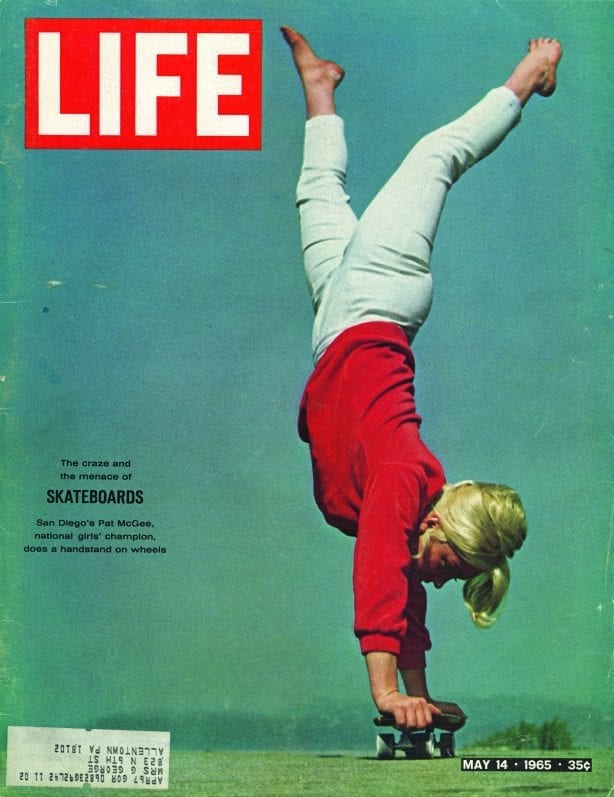
Wait. I want to know about your Life magazine cover. How did that happen?
Before I went to New York, I was in Pittsburgh, Pennsylvania. I had traveled from there to Wheeling, West Virginia, and I was getting ready to do a demo. The flags were all set up and the chairs were set up in a square for me to skate in. I go out to do the demo and they said, “Telephone for Patti McGee.” I went in and answered the phone and it was Life magazine. It was Bill Eppridge calling me. He said, “When you get back to Pittsburgh, I want to go take some pictures of you.” I said “Really? Sure!” When I got back to Pittsburgh a few days later, he met me and took me on top of this mountain that overlooked Pittsburgh at Washington Park. They had asphalt and picnic tables and pine trees and we shot pictures all afternoon. Then he took me back to the hotel and dropped me off and said goodbye. Then Macy’s department store called me and said, “You won. You won over the Vietnam war and the tsunami in Alaska. It’s going to be you on the cover of Life magazine!” I said, “No way!”
Wow. What did you think?
I had to hold my breath for a couple of days. It didn’t seem real. I was only 19. How do you deal with something like that? I couldn’t call my mom because it was long distance. You didn’t just pick up the phone and make a long distance call in those days because it cost like $4 a minute. By the time I got to New York, I checked in with the touring guy and I was told to report the next day to Macy’s Department Store. I said, “Well, how do I get there?” They said, “You go down to the corner and cross the street.” I think I was up on 54th and Lexington. They said, “You go one block and then you take the subway and get off.” I said, “Okay.” I didn’t know where I was going. I get down to the corner in my white Bermuda shorts and my orange Vita-Pakt Hobie top with a skateboard under my arm. I tried to get a cab and I couldn’t and I just stood there and cried. I was like, “What am I going to do?” Finally, somebody got me a cab. They wouldn’t pick me up because there I was, this girl with Bermuda shorts standing on a corner barefoot with a stick with wheels on it.
Wow.
I finally got downtown to Macy’s Department Store and I went upstairs to the offices and they were all going, “You got the cover of Life!” And then everything happened so fast. This was on Friday and they said the magazine would come out on Monday morning. That night they wanted me on What’s My Line? and then they had me on the Johnny Carson show on Sunday night.
So you went and did the Johnny Carson show. Wasn’t that taped in LA?
No. This was way before he went to Burbank. This was when it was taped in New York. They got me all dressed up. Did you ever see my clip? It’s on YouTube. You can see me on What’s My Line? and Arlene Francis nailed it. She asked all these questions and they kept flipping the cards and she guessed me. I was dressed up in a black cocktail dress with diamond drop earrings with my hairdo. That was really hard to do because there were no beauty shops open on Sundays. They had the Blue Law then where nobody worked on Sundays. None of the stores were allowed to be open, so they had to get a gal to come to Macy’s and fix my hair. The next night I was on the Johnny Carson show and I was so sick. I was coming down with the flu and I had to do a handstand, but I did it.
You made it happen. I’m still just completely floored by the Life magazine cover and what it did for you at that time.
Yeah. It got me on the Johnny Carson show and the What’s My Line? show and then they flew me from California to Cleveland to be on The Mike Douglas Show. That’s on YouTube too. That’s a good TV interview. The Johnny Carson show I barely remember because NBC erased it. That’s when videotapes started coming out and they realized that they could tape a show and erase it and tape another show. Scott Starr looked all over the world to find that tape because a lot of Johnny Carson went out to the USO shows, so Scott was hoping he could find it on a USO show, but it just doesn’t exist. They re-ran the show in the summer and I got paid again for the rerun, which was a whole $32.50 to be on the Johnny Carson show. I’d love to find that clip. There is a picture of Johnny Carson and I that came out in Newsweek that same week, so I have that picture, but the rest is just up to memory. I was coming down with the flu and I didn’t feel good and I had to be all happy and do a handstand without throwing up. It was live.
Wow. So you went all over the place.
I did but it was a flash in the pan. It happened really fast. That was 1965 and part of 1966 and then I got called to do the telephone commercial for New England Bell because the Hiltons owned the New England Bell phone company.
FOR THE REST OF THE STORY, ORDER ISSUE #75 AT THE JUICE SHOP…
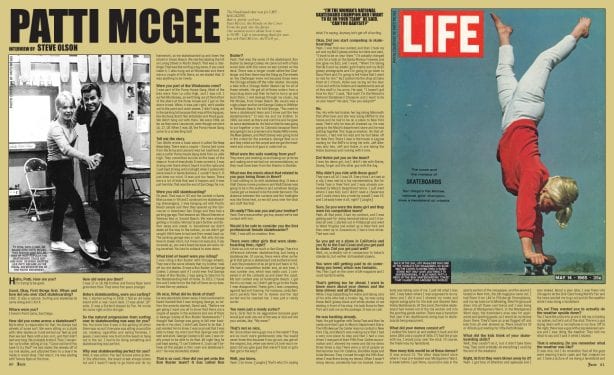
SHARE THIS POST:
- Click to email a link to a friend (Opens in new window)
- Click to share on Tumblr (Opens in new window)
- Click to share on LinkedIn (Opens in new window)
- Click to share on Pinterest (Opens in new window)
- Click to share on Twitter (Opens in new window)
- Click to share on Facebook (Opens in new window)
- Click to share on Reddit (Opens in new window)
- Click to print (Opens in new window)




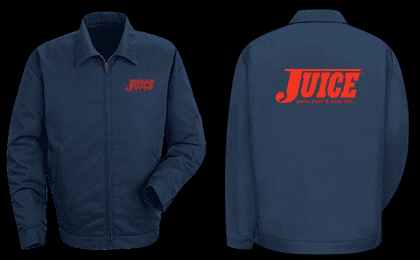
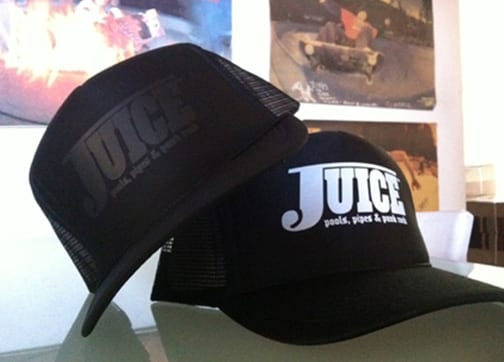





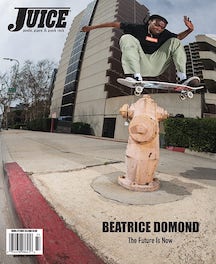
One Response